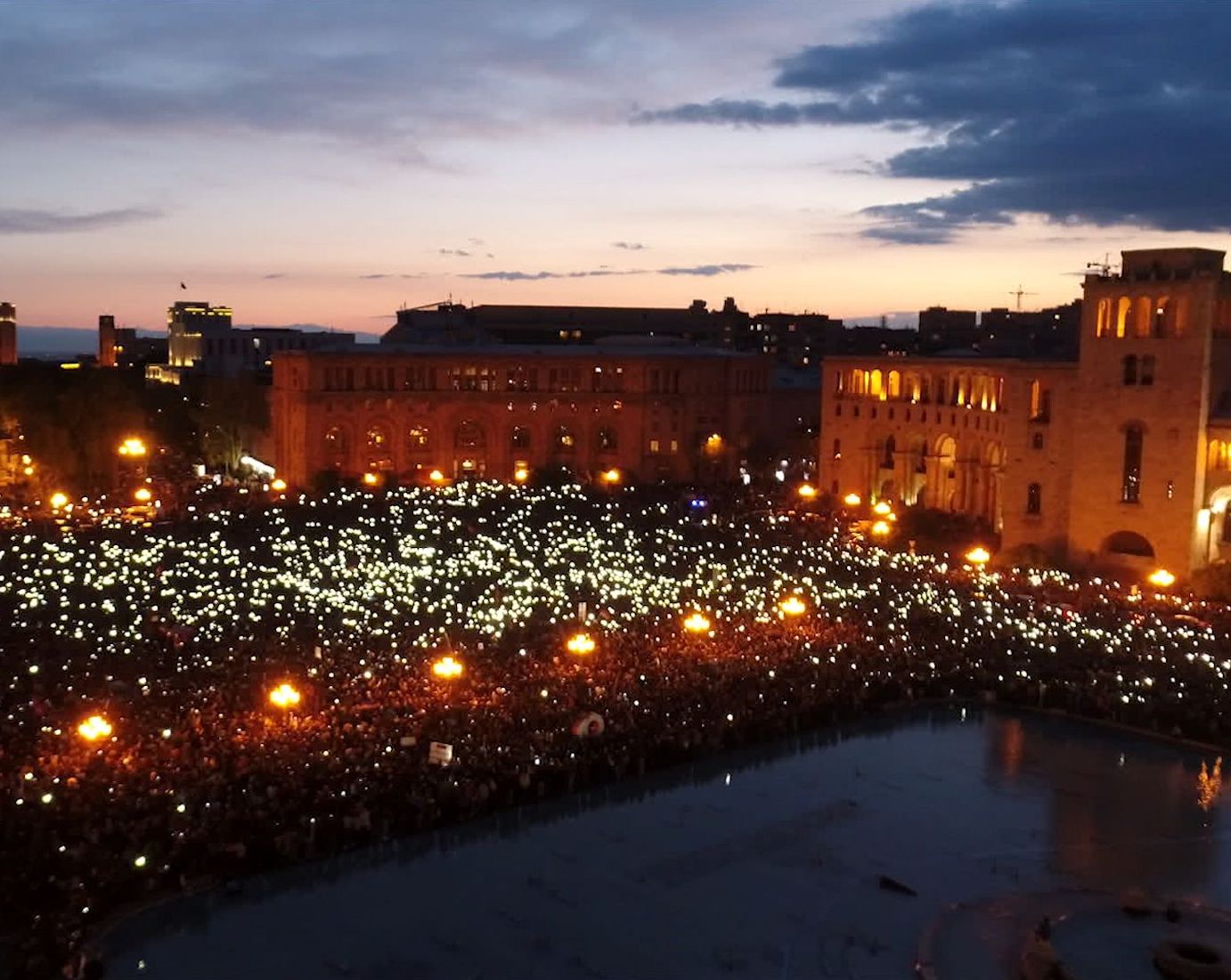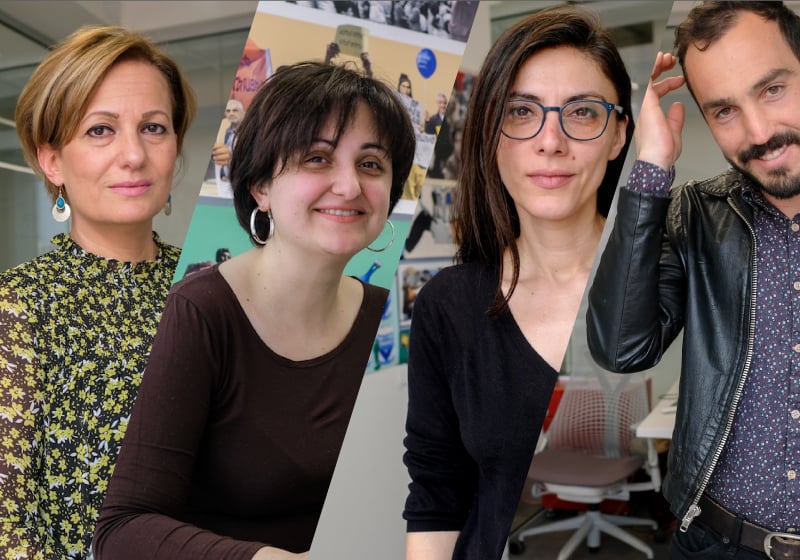Armenia’s Velvet Revolution ignited imaginations. This documentary celebrates its triumph

I Am Not Alone tells the story of the 2018 non-violent revolution that transformed Armenia.
Armenia’s “Velvet Revolution” dominated global headlines in 2018, after hundreds of thousands of protesters brought the streets of Yerevan to a standstill calling for an end to corruption. Documentary film I Am Not Alone follows the revolution step-by-step: growing from a small group of protesters into one of the largest nation-wide non-violent demonstration in 27 years that ultimately lead to former President Serzh Sargsyan’s resignation, and protest leader Nikol Pashinyan being elected prime minister. Thirty-four-year-old Garin Hovannisian was among the demonstrators who joined the movement early on, when Pashinyan began marching across Armenia with his supporters (and a stray dog, who now has both a sizeable social media following as well as a place in the Pashinyan family home).
The poster for I Am Not Alone portrays Nikol Pashinyan and his supporters at a key moment in the revolution.
Born in the US, Hovannisian and his family returned to Yerevan in 1988 to help the victims of the earthquake that killed 25,000 and left hundreds of thousands homeless in Armenia that same year. From an early age, Hovannisian accompanied his father to protests, first for Armenia’s fight for independence, then for democracy. A journalist, historian, and filmmaker, Hovannisian wrote Family of Shadows: A Century of Murder, Memory, and the Armenian-American Dream to mark the centenary of the Armenian genocide. His other major project to date is 1915, a psychological thriller set in Los Angeles about the effects of the pogroms on generations of American-Armenians today.
It was natural that, 30 years after first arriving in Armenia, Hovannisian decided to document the protests of 2018. To make I Am Not Alone, Hovannisian collaborated with Serj Tankian, best known as the lead singer of System of a Down, who is credited as the film’s producer and composer. The documentary tells the story of the 2018 Armenian revolution through protest footage, live streams, and staged interviews with figures from both sides of the barricade.
Following its premiere at the Toronto International Film Festival, where it won the Audience Award, I Am Not Alone will be screening at the Human Rights Watch festival in London on 14 and 15 March.
How did you come to the decision to make a film about Armenia’s Velvet Revolution?
My family, friends, and I have been involved in the struggle to bring democracy to Armenia for many years now, and I always take a camera with me each time I go to a protest. I have a drive full of footage from lots of failed protests. When the 2018 protests started, I didn’t think it would lead to a revolution, I just took my camera and did what I always did. I didn’t know that I was making a film, but a film was born.
What made this protest different from the others you had attended?
If I’m taking a step back, looking at it, for me this protest movement was more fun. Unlike other protests, where people moved into tents and suffered for weeks on end, here, protest fatigue was out of the question. When you got tired, you went home. And the next day, you didn’t even have to come to the same square in the city centre. You could go to your own square, closer to home. Disturb the traffic, organise a concert, play a football game. Live stream it. Decentralised civil disobedience was a key tactic. For the first time, young people were finding creative ways to engage with protest. The whole movement was fuelled by the imagination; it was a revolution of smiles.
Can you tell us about the theatricality behind some shots and scenes?
I think political analysis frequently omits the human emotion and human imagination that, very often, plays a more powerful role in politics than we imagine. Even with all the data and analysis, political forecasts at the time didn’t predict a revolution in Armenia. In fact, the revolution began with Nikol Pashinyan writing a poem — from which the title of the film was taken, I Am Not Alone. This revolution began with an artist making a work of art. I love what Pashinyan said: that he only knew the revolution was possible, when he saw it was able to become a work of art.
I don’t believe that when the film becomes more dramatic, it is somehow less real. Life doesn’t only happen on a political level. Poetry and art are a significant part of our existence. There’s also a fairytale-like character to this film.
The so-called villain also makes an appearance in the film. How did you manage to convince Serzh Sargsyan to give you an interview?
It took over a year to convince him. I went back again and again with the same kind of approach. “You can probably imagine that Pashinyan is going to turn out well from this film, but I come from a journalistic, historical, and theatrical perspective, and this film will be better, more balanced, and engaging if you will allow me to include your words in it.” Eventually, he agreed.
A backstage picture of Hovannisian interviewing Pashinyan. Image: Courtesy of Garin Hovannisian
Quite frankly, I think he comes off better in the film than had he not given the interview. It’s easier to make a villain of someone you don’t see. He was acting out of his own logic and understanding of Armenia’s political chessboard. Part of what we tried to capture were the mechanisms that drove people to protest, and that often they were trying to do what they thought was best for their country. It was as if the police and the protesters were engaged in a kind of dance that caused the outcome of the revolution.
Have Armenians seen this film, and if so, how have they reacted to it?
The film has only played at 14 film festivals so far. It will certainly be released in the US later this year, and then to other countries. It’s going to be a very different experience for Americans, who are distant from the events of the revolution, compared to Armenians who have lived through it and the effects of its fallout. Ultimately, the biggest test for the film will be its return to Armenia, and whether it clashes with how Armenian people experienced the revolution in recent memory.
Serj Tankian of System of a Down produced the film and wrote music for it. Image: Nazli via a CC license
Serj Tankian of System of A Down is the producer of this film. How has he been involved in it?
Serj Tankian has been fully involved, not only in creating the film but also in the protest movement. System of a Down provided one of the main soundtracks of this revolution. Having such an iconic band to have your back as a movement, and as protesters, was very important. Tankian is an important voice in Armenia: everytime he posts about an Armenian issue, the media circulate it in the news. This was my second collaboration with Tankian: he made the music for both this film and my first film, 1915, which looks into how the trauma Armenian genocide continues to affect people’s lives today.
I think if you go on Tankian’s Facebook account, 50 per cent of his posts are about this film. He really believes in it, not just as a chronicle of a revolution, but also as a lesson that positive change can happen. What Armenia has accomplished could be the key we need to share with the world. This film captures the spirit, the methodology, the paradigm of our age of revolution.
I Am Not Alone will be screened as part of the Human Rights Watch Film Festival in London on 14 and 15 March. Grab your tickets here.


